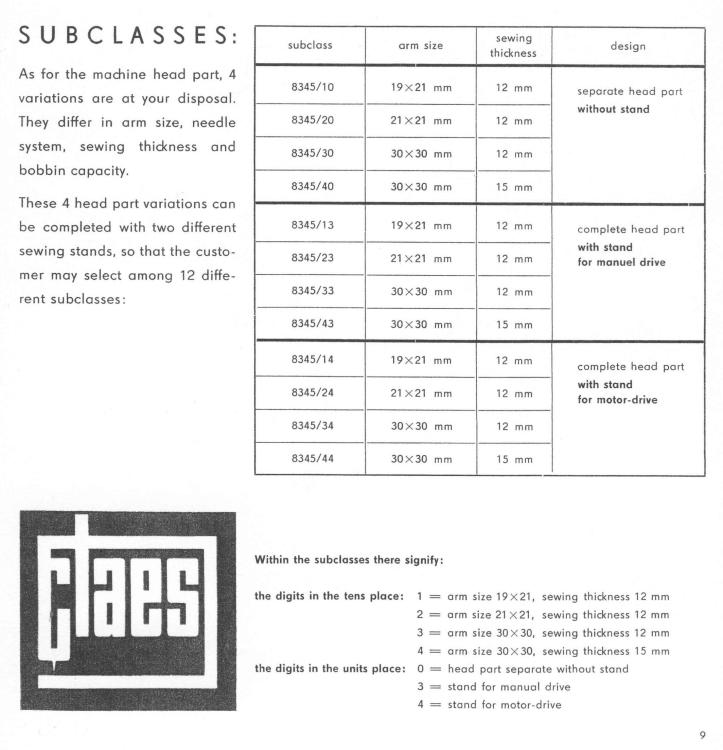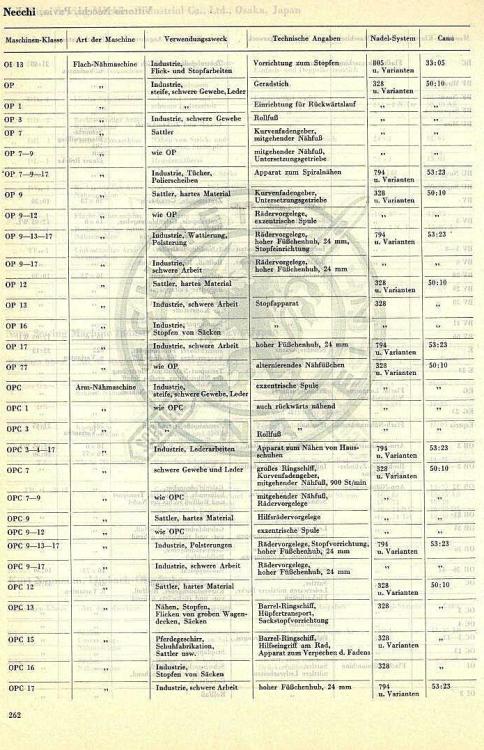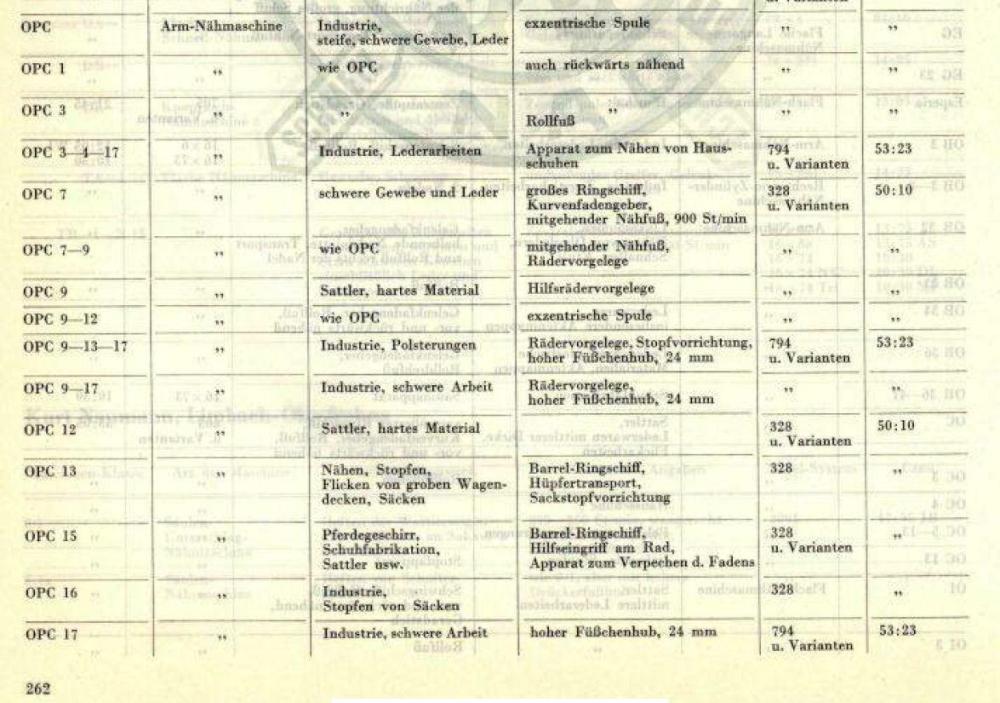-
Posts
5,756 -
Joined
-
Last visited
Content Type
Profiles
Forums
Events
Blogs
Gallery
Everything posted by Constabulary
-

Advice on Singer 34K11 or Adler 5-6
Constabulary replied to Gryning's topic in Leather Sewing Machines
When you want to pick up the bottom thread you have to hold the top thread with your fingers. Send me a PM with your email address so I can forward you a manual for the 34K11 - file is too big to attach here. I think 12mm is pretty much the max. you are able to sew with either of the machines so keep in mind that with 12mm material thickness you run them at their very limit! Not sure if the 34K11 will be good at this at all with it´s rather narrow feed dog. -
I agree and most likely a touch up could make it look even worse cause you will most likely not find a 100% matching paint and the original paint is already a bit aged so that makes it even harder to match...
-
Some pictures of the machine would help so we know how it is set up. But usually yes. Roller foots are fairly cheap an on this machine class they just mount where the regular presser foot is mounted. Depending on the roller size you probably have to adjust the foot bar height. https://www.ebay.com/itm/165207112611
-
You cannot retrofit a walking foot to sewing machines. There are "top feed" attachments for certain domestic machines but that is not even close to what is considered as a walking foot (aka triple feed = bottom feed + top feed + needle feed) in the leather trade. The 17-30 is a light - medium duty cylinder arm machine with drop feed and reverse. Some may have a roller foot some may have a straight presser foot. They have a long beak shuttle with fairly small bobbins.
-
The download link is in the 1st post here: https://leatherworker.net/forum/topic/78444-download-singer-132k6-seiko-sk-8-manual/
-

Claes 8345/34 Patcher Needle Size
Constabulary replied to Kristian99's topic in Leather Sewing Machines
I do not agree that the 34 subclass is the "heavy subclass" - see above list of sub classes. The 34 is the same as the 30 but with motor stand. The motor stand makes it a 34 everything else is like the 30 incl. needle System 88 - the head only w/o treadle or motor stand is the 30. Check the list. IMO the heavier class has the higher foot lift as well, meaning the machine that takes the 214 needles should have a 15mm foot lift. Thats at least how I understand the subclass list. But I`m maybe wrong. How high is the foot lift on your machine? -

Looking for Claes RPX-2 hook/shuttle
Constabulary replied to Farmfield's topic in Leather Sewing Machines
They are expensive indeed! 29K shuttles are not compatible with CLAES. CLAES pathcers are the most excellent patchers (high lift, long stitch length...) nothing better out there. But when it comes to spare parts I would always go with the later Singer 29K models like 29K71 / 72 / 73 cause their parts are still made and affordable. Made in China or Taiwan but still! But well depends on what one needs or expects from a patcher. The later 29K´s are technically more advanced than the earlier model and quite capable when properly set up. -

Claes 8345/34 Patcher Needle Size
Constabulary replied to Kristian99's topic in Leather Sewing Machines
alright - checked the parts list and looks like the 328 / 214 was the needle for the 40, 43 & 44 subclass. So if yours is a 34 (mistyped?) then it takes System 88 and if it is a 43 then it takes the 328 / 214 needle. Confused? -

Claes 8345/34 Patcher Needle Size
Constabulary replied to Kristian99's topic in Leather Sewing Machines
Just checked again looks like they had a 8245 with 328 / 214 needles also. So it is well possible that your machine (subclass 43) takes 328 / 214 needles. BUT the 328 needle system is special cause different needle sizes have different needle shank diameters. Personally I never have seen a 8345 with 328 needles. A rare machine and I know someone who wants one - right. Glenn? -

Claes 8345/34 Patcher Needle Size
Constabulary replied to Kristian99's topic in Leather Sewing Machines
I think the Mod. 200 came in a subclass for 328 / 214 needles. Here is a list of sub classes for the 8345: -

Claes 8345/34 Patcher Needle Size
Constabulary replied to Kristian99's topic in Leather Sewing Machines
The only needle that could probably fit is the 332LG (this is the longer version of the 332 / 29x3). 332LG and System 88 have the same length BUT the 332LG has a slightly larger needle shank diameter than the System 88. So maybe they fit - maybe not. But to be honest I guess they wont but depends on the needle hole in the needle bar. -
Well, the Singer Manufacturing Co. we know for industrial sewing machines is no longer producing industrial sewing machines and no longer exists. They stopped loooooong time ago, several decades ago I´d say. Basically someone has bought the brand name Singer and they are now marketing sewing machines but they no longer manufacture industrial sewing machines in their own plants and The domestics machines are for sure made somewhere in Asia. Singer nowadays is just a brand name among others. The head company is SVP they own the name Singer, Husqvarna / Viking and Pfaff. When it comes to industrial sewing machines don´t expect anything from them, they are just marketing "domestic or consumer" sewing machines but no serious industrial sewing machines (or do they?). All to my best knowledge.
-
just came to my mind - maybe the safety clutch has tripped or one of the timing belt pulleys is loose / loose set screws or the timing belt is a few teeth off.
-

1895-Singer 29 Walking Foot not Lifting
Constabulary replied to JohannaT's topic in Leather Sewing Machines
This is where you have the slider (far to the right) This is where you want the slider (far to the left) - the further left the slider is the higher the foot lift. For moving the slider you have to loosen the wing nut or in your case the small lever on the slider. -
I would guess this rather is a hook timing problem but hard to tell from the distance.
-

1895-Singer 29 Walking Foot not Lifting
Constabulary replied to JohannaT's topic in Leather Sewing Machines
Move this slider to the left that in crease the foot lift. The further left the higher the foot lift. If that does nor help pleas post pictures of where the presses foot is mounted. -
maybe its just the hook that is a bit close to the needle so the gap between hook notch and position finger is too tight. You can move the hook a tiny bit (maybe 0.5mm or so) to the right (if not already flush with the machine arm) by loosening the 2 or 3 set screws on the hook body. Better check the needle hook timing after doing this.
-
You are welcome - always glad when I can help folks with their old sewing cast irons
-
I meant renamed
-

For more torque, I need what?.....
Constabulary replied to Beanwood's topic in Leather Sewing Machines
Make sure the V-Belts are tight enough and do not slip. But anyway - servo motors are the best option nowadays. I run my Singer 111G156 with a 750W servo and small pulley and with a 1:3 speed reducer and it punches trough 10mm thick Mil Spec cotton webbing at slow speed - just saying... Back then I bought my JACK servo from College Sewing in the UK. -

Manual/Literature for Claes 8345/43
Constabulary replied to HatoriKun's topic in Leather Sewing Machines
I´m in touch... -
I just went trough my sewing needle records and found that NECCHi made a machine class called OPC. Maybe it is an abbreviation or maybe OPC was an earlier class and they later remanded it with a number system or the other way around - I don´t know. https://www.google.com/search?client=firefox-b-d&q=NECCHI+OPC https://cambriacuciti.it/negozio/aghi/aghi-industriali/aghi-328/ Hope this helps - sorry it it in German language:
-
But the NECCHI 643 seem to exists and the 110 is (as on other sewing machines too) the subclass that describes technical details or how the machine was set up when it once left the factory. However NECCHI machines of the Class 643 are quite rare as it seems. This is a NECCHI 643 but set up as darning machine: https://www.youtube.com/watch?v=zwdUIyglEnE Bobbins / hook for the 643; https://www.ebay.com/itm/124505097381 https://www.amazon.de/Shuttle-Haken-geschlossener-Rahmen-Spulen-Singer/dp/B07Q313P6S So I think the data plate on the machine "could" be right - not sure though. I have a 45K and I know the Adler 5 - they usually can sew 12mm leather. But it depends on how the machine is set up. The Singer 45K´s and Adler 5 usually have a much larger / heavier hand wheel you at least need a powerful servo motor (would recommend 750Watts) with small 50mm pulley and I personally would add a speed reducer as well for slowing down the sewing speed and increasing the torque. I`m can use needles up to size 250 (metric) but I seldom do I usually sew with 180 or 200 needles with 11/3 (metric) thread. The needle system on these machine usually is 328 or 214x2
-
I still would assume you need a larger needle or a thinner bottom thread and / or try a heavier beehive spring on the tension unit. If the former owner sewed fabric then the spring may be too weak. This is from College Sewing in the UK but you will find them on your end as well: https://www.college-sewing.co.uk/b3114-232-000-beehive-spring-heavy-juki-genuine.html When you haven lowered the foot on the material do the tension discs feel kinda loose or wiggly?
-
It´s a clone of the Singer 45K or Adler 5. It´s a drop feed machine w/o reverse. The Adler 5 or Singer 45K manual will work for this machine Since it is made in Italy I would guess it was made by NECCHI. So it´s a NECCHI 643-110 I´d say.







